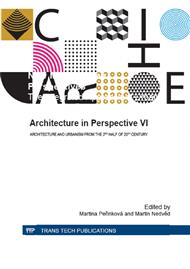p.132
p.137
p.141
p.147
p.153
p.158
p.164
p.171
p.176
Automobile in the Disposition of Energy-Saving Houses
Abstract:
In the disposition of energetically economic houses, automobile abandons its stereotype held for so many years according to which it was placed to rest “under one roof” with other residential and utility rooms. However, this diagram shows a range of collisions manifesting with difficult building details, with occurrence of thermal bridges and thermal relations. This results in increased financial demands for drafting efficient thermal insulation layers or higher demand for energy consumption necessary to heat up the building. Generally, architects and structural engineers are not sufficiently aware of the fact that at the same time this is a factor that provides higher potential for faster ageing of car bodies and chassis when cars are parked “inside the house” than in means of transport parked in open carports or in an open space. This Paper deals with analyses of this important, yet often omitted or less-known fact.
Info:
Periodical:
Pages:
158-163
Citation:
Online since:
November 2014
Authors:
Permissions:
Share:
Citation:


